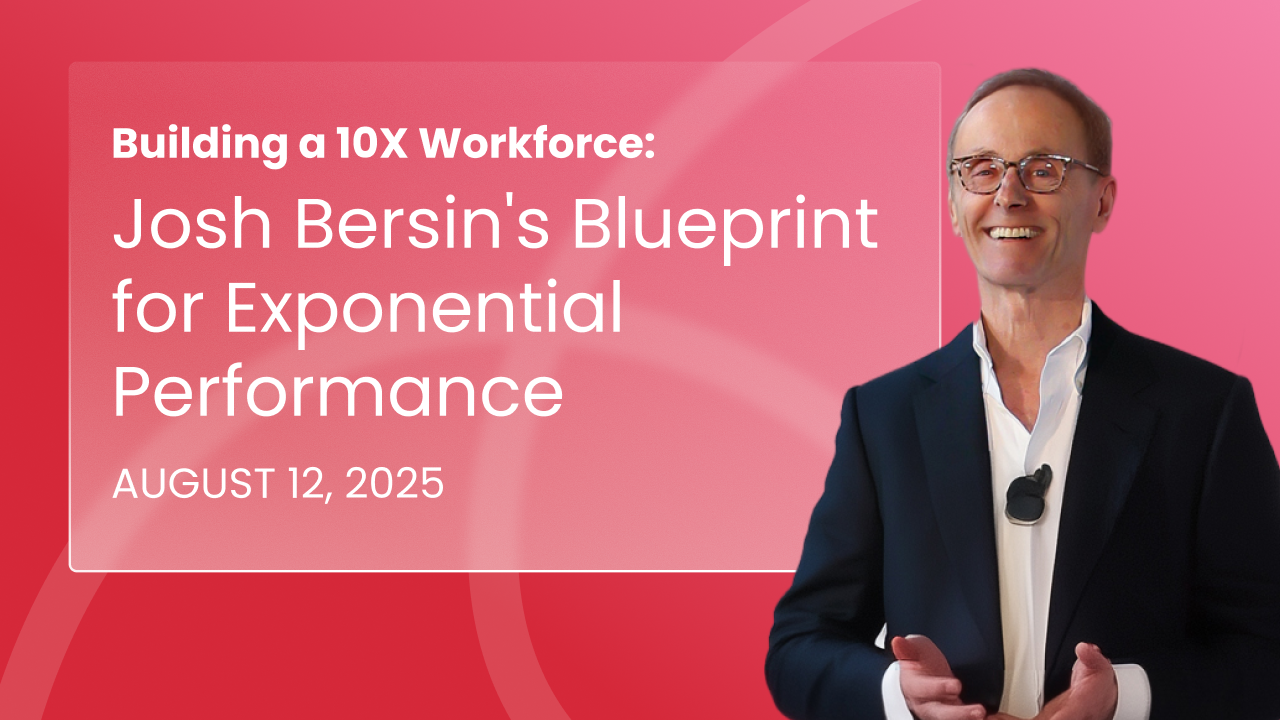Job architectures: what they are and how they help unlock potential
Learn why job architectures are a game-changer for empowering and inspiring your workforce

By now, most leaders know that skills-based tactics are the work strategy of the future. Although organizations are eager to bring skills strategies to speed and scale, companies often lack the tools and infrastructure needed to turn these visions into realities.
Rather than gradual adjustments, leaders must fundamentally change the way work is allocated and organized to embrace skills strategies. Skills-based organizations shift from viewing jobs as the fundamental unit of work to reallocating talent based on capabilities and capacity.
Although work may no longer be broken down into jobs, that doesn’t mean that it’s time to disregard job architectures. In fact, job architectures will become even more important as companies become skills-based organizations because these systems showcase the competencies employees need for various roles and spotlight the transferable skills that companies can tap into to reallocate talent as priorities shift and new challenges emerge.
What is a job architecture?
A job architecture is a structured framework that defines job roles, levels, responsibilities, and compensation across an organization. It standardizes career paths, aligns talent strategy with business goals, and supports workforce planning. Companies use job architectures to promote transparency, equity, and consistency in employee development and pay.
Typically, organizations may pull from a predefined catalog or work internally across teams to define a job architecture. However, these frameworks can be time-consuming to maintain and difficult to keep accurate because employees’ skills and the roles that an organization needs evolve. That’s why leading companies are tapping into a new generation of AI-powered skills intelligence tools like Gloat’s Skills Foundation.
With these offerings, leaders can keep roles and responsibilities updated with insights from external and internal data sources, view suggested positions to merge and job codes to update, and receive recommendations on relevant and trending skills that should be prioritized. Job architecture tools let leaders create and manage job designs in real time and help executives understand the best skills for a job, view compensation benchmarking, and write descriptions that accurately reflect the scope of the role.
Why are job architectures important?
From creating more informed talent acquisition decisions to fueling better talent development processes, job architectures offer a handful of key workforce benefits. The five main reasons that job architectures are so essential are as follows:
#1. Understand your organizational structure
Job architectures create clear definitions of what goes into various roles, giving hiring managers the information they need to make strategic talent acquisition decisions and find the right people for open positions. They improve clarity and help employees understand where they fit into the organization and the expected skills required to be successful in their roles. This added transparency also offers insight into how various positions might relate and interact with each other.
#2. Transform talent acquisition
An updated job architecture can streamline talent acquisition processes and ensure managers are hiring for the skills they need. By spelling out the responsibilities associated with each role and the skills required to excel in it, hiring managers can refer back to their job architecture to make sure they’re interviewing candidates who possess capabilities that align with the scope of the role.
Job architectures can also help employees who are considering moving into a new position internally by giving them a clear picture of the role they would be taking on and the competencies needed for it.
#3. Facilitate talent development
Job architectures can help managers and employees ensure they’re building skills that are relevant to current roles as well as future positions they hope to hold eventually. These systems spell out exactly what skills employees need to be successful in various positions, based on both internal and external data. Employees can then use this information to evaluate how their skills stack up to the competencies outlined for different jobs and discuss learning opportunities that will help them bridge existing knowledge gaps with their managers.
#4. Enhance employee engagement
By creating a shared sense of transparency and a common understanding of various roles, job architectures can boost employee morale and engagement across the organization. Rather than being uncertain about the impact they’re expected to make, employees can consult their company’s job architecture to get a clear picture of their responsibilities and how they relate to business priorities.
#5. More effective performance management
Job architectures take the uncertainty out of most performance management conversations. When a company’s job architecture is updated and accurate, employees and managers both have a clear understanding of what’s expected of them based on the roles they’re in. There’s no need to guess what skills might be useful to help employees take their careers to the next level; instead, people can consult their job architectures, which clearly spell it out—inspiring employees to start building the skills they need to qualify for their dream roles within the company.
Job architectures also make it easier for managers to have frank discussions about employees’ performance and progress when their skills are falling short of the competencies that are outlined for their role and seniority level.
Setting up your job architecture
Given the benefits outlined above, it’s easy to understand why so many leaders view job architectures as essential systems that support how their businesses work. Setting up a job architecture is a complex process that has traditionally been comprised of the following components:
#1. Define roles
The first step in your job architecture journey is to classify and define all roles within your company and outline the responsibilities that each of these positions oversee. The responsibilities can be split up amongst various roles and extend beyond a particular job function.
#2. Develop job descriptions
Once your roles are clearly defined, it’s time to create job descriptions that break down the key competencies required for each position and what someone stepping into the role is responsible for. If you’re using a Human Resources Information System (HRIS), jobs are usually linked to job codes.
#3. Form job clusters and families
The next step is to see how various job relates to one another by creating job families, or clusters of similar jobs sharing professional and core tasks. The more similar the characteristics of a job family, the easier it is to group jobs together and create sub-families.
#4. Perform job evaluations
Once you see how roles relate to one another, the next step is to systemically and accurately assign value to individual roles. Their value will be determined by the knowledge, qualifications, and skills required to do a particular job. Job leveling must also take into account the influence of the role and the outcome of a role to ensure job titles are aligned.
#5. Align with industry benchmarks
When all job titles and levels within your organization are confirmed, it will be much easier to align individual roles with their respective pay benchmarks. This allows for the appropriate salary levels to be set and for correct and fair compensation structures to be put in place.
#6. Finalize job titles
The last step in a traditional job architecture process is to revisit your organization’s job titles after researching external job structures. For example, you might notice that a role that you’ve titled one way is actually called something else by many of the competitors in your industry. Titles should be market-related and follow norms and conventions to maximize the quality of the candidate pools you’ll attract.
How to create a modern job architecture
Ready to level up your job architecture? While the process outlined above used to be the only way to create a job architecture, a new wave of AI-powered innovations has the potential to streamline this process. Here are 3 best practices for upgrading your job architecture:
#1. Harness skills intelligence tools
In the past, job architectures were challenging to build and maintain because the entire process was manual. HR leaders needed to pull from pre-defined catalogs and collaborate with teams across their organization to create an architecture and then constantly update it as skill needs and priorities changed.
Rather than getting stuck in this tedious process, visionary leaders are now turning to skills intelligence tools to create their job architecture. These systems let leaders keep roles and responsibilities updated with insights from external and internal data sources, view suggested positions to merge and job codes to update, and receive recommendations on relevant and trending skills that should be prioritized.
#2. Ensure skill-building aligns with organizational strategy
Once leaders have a job architecture in place, they must ensure that the skills they’re asking people to build align with the direction their company is heading in and their bottom-line priorities. Since skills intelligence tools can update job architectures in real-time, leaders can trust that the skills and responsibilities associated with various roles will continue to evolve as business needs shift.
#3. Embrace flexibility and agility
In a world that’s hallmarked by rapid shifts and ongoing uncertainty, leaders must expect and prepare for their strategies to continuously change. Executives can use their job architectures to help their organizations prepare for and respond more quickly to change.
For example, job architectures that spell out what skills are required for various roles can help leaders redeploy talent in ways that they may have never considered before. Rather than simply moving people within the same department or functional group, skills intelligence tools shed light on the transferable skills that might make an employee from a different team an ideal fit for a job within another part of the organization—in turn ensuring the company is unlocking their workforce’s full potential.
To learn more about the role job architectures can play in bringing skills-centric strategies to life, check out our ultimate guide to the skills-based organization.





